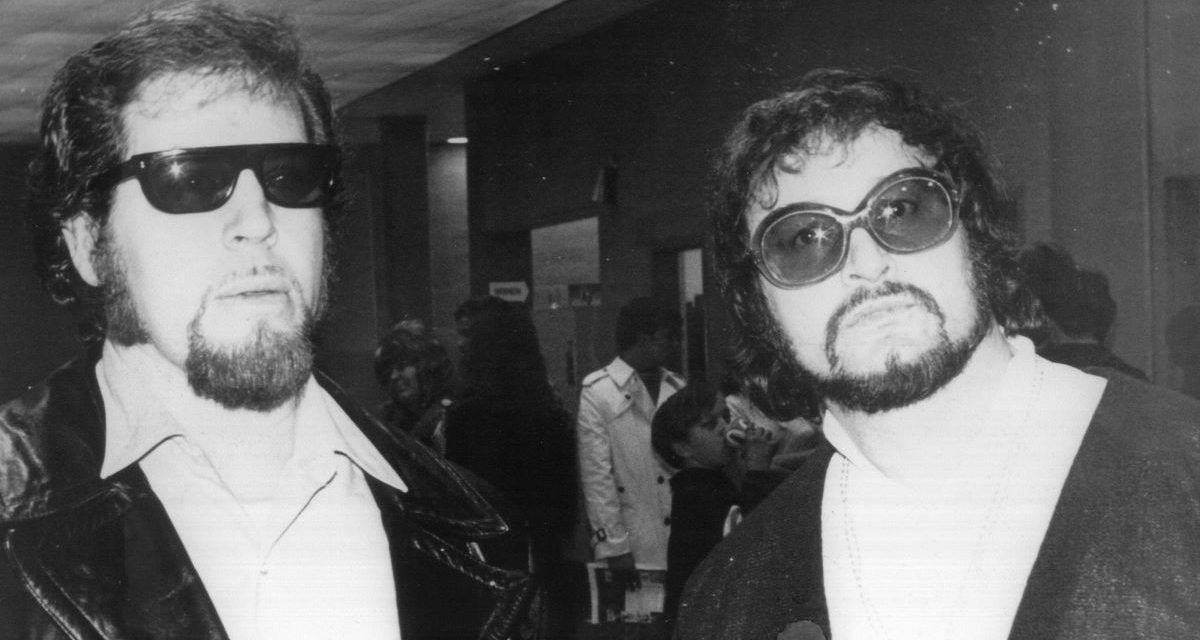He may have found fame as the heelish hippie Hartford Love, but Wes Hutchings is a heroic Newfoundlander through and through.
“Down here, I’m like God to Newfoundland. I’m not blowing my own horn or nothing, but I’m a Newfoundlander, and when I came back home, I changed my style of wrestling,” Hutchings said. “My parents had moved back and I wanted them to respect me, I wanted my countrypeople to respect me, so I changed from a bad guy to a good guy. So I became popular all over this island and Labrador. I became the number one guy here.”
Even now, years and years removed from his last match in 1988, “They still think of me as Hartford Love.”
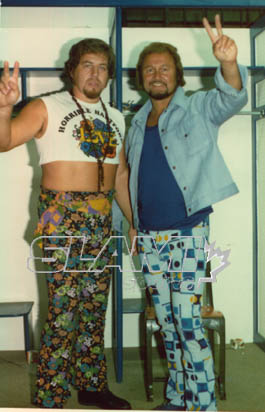
Hartford Love and Reginald Love — The Love Brothers. Photo by Mike Lano, WReaLano@aol.com
Born in Spaniard’s Bay, Newfoundland, in 1940, Hutchings moved back there in 1980 and never left.
His parents had moved to Hamilton, Ontario, when he was about seven years old, and his father, Ambrose, found work at Westinghouse.
Young Wes was always into sports. A neighbor was Jerry Dorsey, who was one of the dozens and dozens of men who wrestled in and around Hamilton, and the reason that “The Hammer” was called “The Factory” for producing so many wrestlers.
Hutchings admired Dorsey, and frustrated already by his early days in the grimy steel mills, he sought out something else. “I was kind of impressed with him and what he was doing at the time. So I went to Al Spittles’ gym and told him I wanted to become a wrestler. He said ‘C’mon up’ and I went up and they beat the heck out of me for a few years. I gradually learned, gradually kept going back.”
Not allowed into the wrestling ring until he hit 200 pounds, the six-foot Hutchings eventually made it up to the 240-260-pound range. His initial matches took place around southern Ontario and northern Ontario for Larry Kasaboski. He also ventured down to Pittsburgh to be used as cannon fodder on the TV shows.
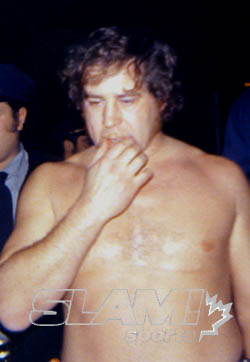
Hartford Love. Photo by Steven Johnson
He had a variety of names at the beginning, including Wes Hutchings in New York, and teamed with other Hamiltonians like John Quinn and Terry Yorkston. “We were masked men. I wrestled in Quebec as Pierre Lasalle for a couple of times when I went to Montreal. I wrestled as the Hangmen. I wouldn’t even be able to name them all. When you’re starting out, that’s the kind of thing you do.”
Another Hamiltonian, originally from Wales, Johnny Evans, was destined to change Hutchings’ life. They didn’t know each other well, having met in the gym here and there, and teaming for occasional spot shows.
Buffalo promoters Johnny Powers and Pedro Martinez are credited with the idea of the Love Brothers, and pairing up Evans and Hutchings in 1969; it’s likely the idea came from Jerry & Bobby Christy, who had found success in California as the Peace Brothers.
“When John and I got together, that’s when we clicked together. We knew each others’ moves, we just got to be good wrestling partners,” said Hutchings.
“I needed to freshen up,” said Powers of the decision to create new personae. “I threw them together, Wes Hutchings and Johnny Evans, and one took the bumps, the other one was great on the mike … they were both great athletes.”
That distinction, that one of them — Hartford — did all the work, while the other — Reginald — did all the talking, is one both readily acknowledge.
“He was good at everything,” said Evans of his partner. “I did all the talking. When he was driving, everything was fine. When I was driving, not good. So I let him do the driving.”
Angelo Mosca said that “Hartford was the better worker.”
“[Reggie] could talk, but he never took a f—ing bump in his life,” Mosca continued. “The other kid made more money. Hartford was a hell of a worker.”
Billed from Cardiff, Wales, the magazines said that the Love Brothers grew up learning the “rugged Welsh-Cumberland style of holds and moves.” They would wear flower-patterned outfits, outlandish sunglasses for the times, and love beads.
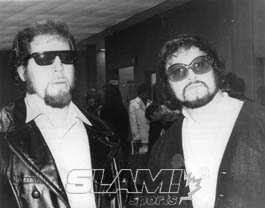
The Love Brothers model some big sunglasses. Photo courtesy Johnny Evans
They were natural heels, eye gouging, stomping, working the babyface over in their corner.
“Jesus, the people hated us. You’ve either got to be well-liked in wrestling or well-hated, and we were well-hated so we were making good money. People wanted to come see us, these two Love Brothers that were causing all the trouble,” said Hutchings, who said that he eventually came around to the groovy duds. “Not at first, but it kind of grew on me! It was the hippie years. Everyone was doing it at that time. We weren’t as odd as we thought we were.”
Though Evans could talk a dime out of a phone, managers were all the rage in the 1970s, and Al Costello and “Beautiful” Bruce Swayze fit the bill at various times.
“A lot of teams at that time had managers. It was just another part of wrestling. It helped in ways. That way we could run six-man tag teams,” said Hutchings.
“We were hot,” claimed “Beautiful” Bruce. “We got a lot of heat, the three of us. If I think about it now, wow, unbelievable. As much if not more than they’re getting with anybody out there now. We could hardly get to the ring, let alone getting out of it.”
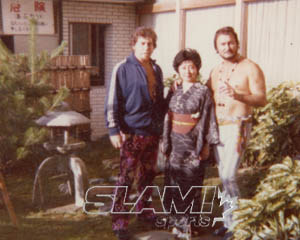
The Love Brothers in Japan in 1972. Photo courtesy Johnny Evans
The Love Brothers worked around southern Ontario, the Buffalo-based Steel Belt territory, and the Charlotte-based IWA in competition with the established NWA promotion, as well as a 1972 tour of Japan.
Frequent opponents included the Crusaders (Billy Red Lyons and Dewey Robertson, with and without masks), and Whipper Billy Watson and his partner of the night.
“I used to love wrestling him,” Hutchings said of The Whip. “The guy didn’t do much, he was so big. He used to have to lay down before he went out to the ring, and the doctor would take his blood pressure, because it was always high. He used to have to lay down until his blood pressure went down a bit. Then they’d let him go in the ring.”
Evans remembers talking with Powers, who said that the Love Brothers extended Whipper Watson’s career by a couple of years.
“I never looked at it that way, but we did. It was the Love Brothers and Watson and Haystack [Calhoun], the Love Brothers against somebody and Watson. Over and over and over,” said Evans, launching into a story.
“I’ll never forget, we were in St. Catharines, and Whip used to go at 238, but had to be 283 — see the size of his legs, his ass? I could tell he was tired, and we’re beating him in the centre, and I give him a bodyslam. I guess he thought I couldn’t do it! Once you get the ass up, the head goes down. He got up, and I hear him walking around the ring, ‘Christ!’ (laughs) Those little things I never forget.”
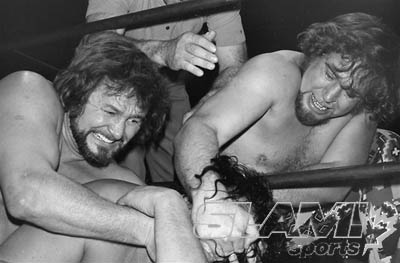
The Love Brothers double team an opponent in the corner in 1971. Photo by Dave Burzynski
More than a decade older than Hutchings, Evans’ back gave out and he was forced to quit the wrestling business.
Hartford hit the road on his own, including trips to South Africa, Charlotte and, perhaps most memorably, in Puerto Rico, where he was a champion.
“I loved Puerto Rico, but they hated me down there,” Hutchings said. “I went down there and took over the championship, and lived on the beach. Actually, I couldn’t go on the beach on the weekend though, because they’d kill me. I had the blond hair, and they’re a little darker people down there. I used to call them la cucarachas, which is cockroaches in Spanish, and they hated me. There weren’t too many places I could go down there. I loved the weather down there. Some of the people were great, but you had to be very careful. No ringside down there. One guy got it for a hundred stitches, so they cut out ringside. They’re very tough people. You had to be very careful.”
He left after Gorilla Monsoon dethroned him for the North American title.
Back in Ontario, the Love Brothers tried promoting together in the 1970s.
“We didn’t do too bad. We had a gym on Barton Street. We used to train and we promoted shows,” Hutchings said of the Hamilton-based operation. The pair had their own ring, and Bull Johnson took it around, set it up, and worked The Mongol on the shows.
They didn’t have a specific deal with Toronto promoter Frank Tunney, with whom they had had a falling out with, but “we promoted towns he wasn’t worried about anyway,” said Hutchings.
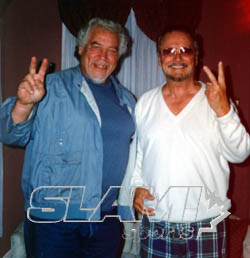
The Love Brothers reunite in 1998. Photo courtesy Johnny Evans
Later, back in Newfoundland and Labrador, Hutchings was a key figure in George Cannon’s Superstars of Wrestling — and the ring from the promotion is still at his home.
At the time, Newfoundland was still “in a way” virgin territory and a risk.
“He had me, and because I was a Newfoundlander and I wrestled all over Newfoundland, the small towns everywhere, and Labrador. They called me Newfie Power. I was the champion down here,” said Hutchings. “I was a Newfoundlander. Local boy makes good.”
Dave “The Wildman” McKigney promoted the province in 1988, and on July 4, 1988, his van crashed, killing himself, Adrian Adonis and Pat Kelly; Mike Kelly survived the crash. Hartford Love worked Adonis’ last match — and it was his final bout too.
“That was the end of my wrestling career. I couldn’t wrestle any more. I was getting at that age anyway. They were all good buddies of mine and I just couldn’t do it anymore,” he admitted.
Still recognized around the province, Hutchings and his wife, Beth, who is from Tennessee, live next to Conception Bay. Post-wrestling, he ran The Sportsman’s Lounge, sold antiques, and now the couple have a pair of taxis.
A heart attack survivor more than 15 years ago, Hutchings has the requisite aches and pains of ex-athletes — a bad back, twisted fingers, a flattened nose, stomped-in toes.
But the wrestling business hasn’t completely left him either.
“I still have my ring here. I’m thinking about promoting here next year.”
